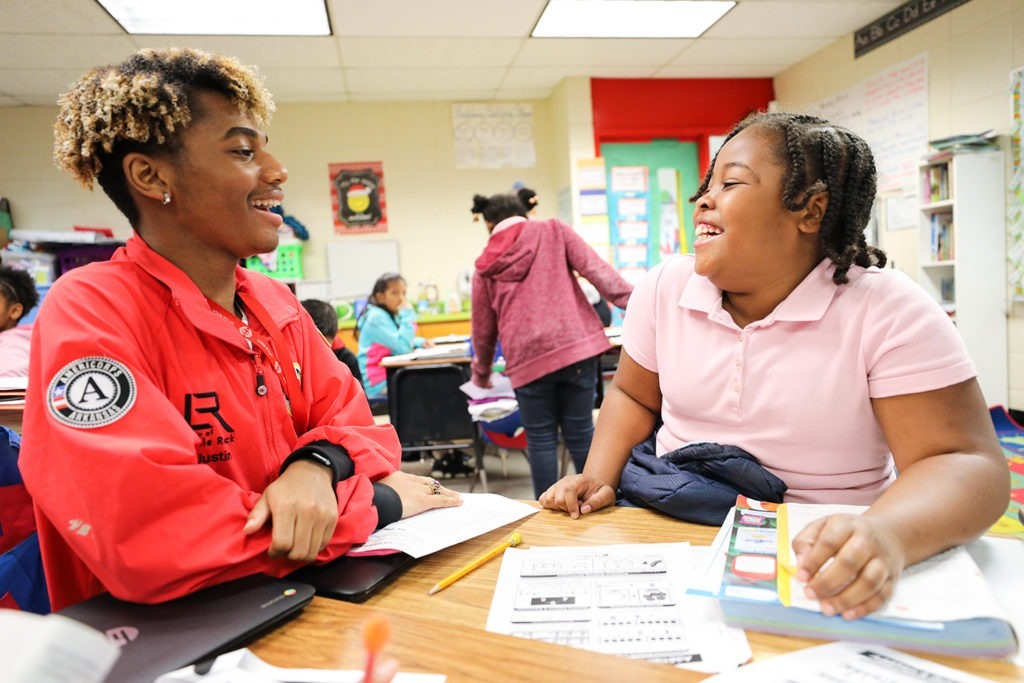The power of national service: building a more equitable future

As City Year celebrates its 30 years of service and AmeriCorps turns 25, the idea of national service as a catalyst for bringing people together to solve our biggest challenges and cultivate the next generation of leaders has captured the attention of 2020 presidential candidates and congressional leaders. Surveys show that both Democrats and Republicans support the expansion of national service, and to date, more than 1 million Americans have served with AmeriCorps since 1994.
It was the spring of 1993 and my college graduation was fast approaching, when a mentor suggested I apply to a service program called City Year. While I thought this would be a one-year detour on my way to grad school, my decision to apply and then serve with City Year is one that changed the trajectory of my life and persuaded me of the unique, necessary role that national service can and should have in our country. During my year of service with City Year, I came to understand the three big ideas behind national service:
National Service is a Civic Rite of Passage
National service can help our democracy live up to its full potential by creating a civic rite of passage. A year of national service connects us to the fullness of what democracy and citizenship should be–teaching us the shared responsibility we have to each other and showing us what can be achieved through collaboration and determination.
I learned the value of showing up day after day in my community to serve a class of kindergartners at a Head Start program in Boston. I learned how to channel my energy into a form of power that was constructive, meaningful and humble. Through serving students in that one school, I became aware of the power we all have as citizens to strengthen our country and our communities.
A Shared Service Experience Breaks Down Social Barriers
National service can break down social barriers by bringing together diverse young people to work together in common purpose. A shared service experience builds connections between people from different racial, cultural, linguistic and socio-economic backgrounds in a way that is often rare in the United States.
It was not until my service year that I realized that most of my social and educational experiences, including my undergraduate years at a large, urban university with students from across the country and the globe, were not as diverse as I had thought. However, on my City Year team, I served alongside my peers from diverse racial and ethnic backgrounds, educational levels and experiences, and various cities and states.
By learning to connect, empathize and problem-solve with one another through our shared commitment to service, we came to realize that our diversity was our greatest strength.

Young People are an Untapped Resource for Creating Positive Change
Our young people are largely an untapped resource. When supported in the right ways, the energy, passion and idealism of young people can yield incredible things. Throughout history, young people have consistently been underestimated by older generations. And yet, young people are almost always the drivers of positive social change.
I began to realize the impact I could make during my service year when the teacher at my Head Start program pulled me aside one day. She explained to me how important it was for each child to have the opportunity to build healthy, developmental relationships with caring adults, including family members, teachers, coaches and mentors. Some of her students didn’t have enough access to these relationships and she encouraged me to embrace the challenge of being there, every day, for those children. By helping these students feel confident, valued and cared for through seemingly small actions every day, I could help them discover pathways to succeed in school and in life.
Building More Equitable Environments
Those three big ideas propelled me to continue serving with City Year as a staff member after my year of service and have continued to inspire me.
Today, at a time of deepening racial and economic inequities, I have come to realize the fourth, and perhaps most important, big idea behind national service: its potential to build a more equitable, just and hopeful future by creating environments where each person has a chance to fully develop and thrive.
Social justice activists and leaders, including Bryan Stevenson, call us to be proximate to the inequities that exist in our communities and “lean into justice” even, or especially, when doing so makes us uncomfortable. National service provides us the opportunity to get close to these inequities–whether through legal assistance, health care, disaster relief or education–and work to address them through direct service and systemic transformation.
In schools challenged by persistent systemic inequities, City Year, Jumpstart, Teach for America, Reading Corps and other programs fueled by national service, strive to create safe, welcoming and challenging learning environments where each child is valued and believe they can succeed. The nurturing of these positive environments extends beyond schools. National service organizations, such as FEMA Corps, Red Cross Corps and American Youthworks, provide natural disaster relief for hard-hit communities, while AmeriCorps VISTA serve hundreds of nonprofit organizations and local government agencies that are committed to the eradication of poverty and the expansion of opportunity. Other national service programs support veterans and their families adjust to civilian life after military service and access economic, health and educational services that help them gain security and stability.
In schools, communities, towns and cities, through education, disaster relief, social justice efforts, veteran support and everything in between, national service is working to create, strengthen and support environments where all people can develop and thrive, particularly populations that are often overlooked and underserved.
It’s encouraging to see so many presidential candidates and congressional leaders calling for an expansion of national service, arguing for the unique and necessary role national service can play in transforming our country. A new bipartisan national campaign, Serve America Together, is urging all 2020 presidential hopefuls to release their plan to expand and strengthen programs like AmeriCorps during their first 100 days in the Executive Office.
As we seek to tackle the divides that separate us, I am more certain than ever that national service is one of the best ways for our country to have more collective, shared experiences that help to build a more just, equitable and hopeful future.
Jim Balfanz is the president of City Year. During Balfanz’s tenure, City Year has expanded to serve 350 systematically under-resourced schools in 29 cities and deepened its impact through strong partnerships, school improvement models, tools and strategies designed to prepare students with the skills and mindsets they need and deserve to thrive in school and in life.
This blog was originally published on Jim Balfanz’s Medium on 7/22/2019.
Related stories
Yes, the holiday season can be stressful—making travel plans, wrapping up work before winter break, figuring out what gifts to...
Read more about Three reasons students may be thankful for their student success coachEvery year, thousands of young people decide to join AmeriCorps programs for a year (or more!) of service, helping to...
Read more about Everything you need to know about returning for another year as a City Year AmeriCorps memberCity Year is committed to providing our AmeriCorps members with resources, opportunities and support that help them to achieve their...
Read more about Empowering Futures: City Year Baton Rouge’s Partnership with Bottom LineFatimah Abdulmateen takes service seriously. Fatimah served two years with City Year as an AmeriCorps member, making her an alum...
Read more about A City Year alum with a passion for service—both here and abroad















